Zhenyu Hou
Controlling Large Language Model with Latent Actions
Mar 27, 2025Abstract:Adapting Large Language Models (LLMs) to downstream tasks using Reinforcement Learning (RL) has proven to be an effective approach. However, LLMs do not inherently define the structure of an agent for RL training, particularly in terms of defining the action space. This paper studies learning a compact latent action space to enhance the controllability and exploration of RL for LLMs. We propose Controlling Large Language Models with Latent Actions (CoLA), a framework that integrates a latent action space into pre-trained LLMs. We apply CoLA to the Llama-3.1-8B model. Our experiments demonstrate that, compared to RL with token-level actions, CoLA's latent action enables greater semantic diversity in text generation. For enhancing downstream tasks, we show that CoLA with RL achieves a score of 42.4 on the math500 benchmark, surpassing the baseline score of 38.2, and reaches 68.2 when augmented with a Monte Carlo Tree Search variant. Furthermore, CoLA with RL consistently improves performance on agent-based tasks without degrading the pre-trained LLM's capabilities, unlike the baseline. Finally, CoLA reduces computation time by half in tasks involving enhanced thinking prompts for LLMs by RL. These results highlight CoLA's potential to advance RL-based adaptation of LLMs for downstream applications.
Real-time Spatial-temporal Traversability Assessment via Feature-based Sparse Gaussian Process
Mar 06, 2025Abstract:Terrain analysis is critical for the practical application of ground mobile robots in real-world tasks, especially in outdoor unstructured environments. In this paper, we propose a novel spatial-temporal traversability assessment method, which aims to enable autonomous robots to effectively navigate through complex terrains. Our approach utilizes sparse Gaussian processes (SGP) to extract geometric features (curvature, gradient, elevation, etc.) directly from point cloud scans. These features are then used to construct a high-resolution local traversability map. Then, we design a spatial-temporal Bayesian Gaussian kernel (BGK) inference method to dynamically evaluate traversability scores, integrating historical and real-time data while considering factors such as slope, flatness, gradient, and uncertainty metrics. GPU acceleration is applied in the feature extraction step, and the system achieves real-time performance. Extensive simulation experiments across diverse terrain scenarios demonstrate that our method outperforms SOTA approaches in both accuracy and computational efficiency. Additionally, we develop an autonomous navigation framework integrated with the traversability map and validate it with a differential driven vehicle in complex outdoor environments. Our code will be open-source for further research and development by the community, https://github.com/ZJU-FAST-Lab/FSGP_BGK.
Advancing Language Model Reasoning through Reinforcement Learning and Inference Scaling
Jan 20, 2025



Abstract:Large language models (LLMs) have demonstrated remarkable capabilities in complex reasoning tasks. However, existing approaches mainly rely on imitation learning and struggle to achieve effective test-time scaling. While reinforcement learning (RL) holds promise for enabling self-exploration and learning from feedback, recent attempts yield only modest improvements in complex reasoning. In this paper, we present T1 to scale RL by encouraging exploration and understand inference scaling. We first initialize the LLM using synthesized chain-of-thought data that integrates trial-and-error and self-verification. To scale RL training, we promote increased sampling diversity through oversampling. We further employ an entropy bonus as an auxiliary loss, alongside a dynamic anchor for regularization to facilitate reward optimization. We demonstrate that T1 with open LLMs as its base exhibits inference scaling behavior and achieves superior performance on challenging math reasoning benchmarks. For example, T1 with Qwen2.5-32B as the base model outperforms the recent Qwen QwQ-32B-Preview model on MATH500, AIME2024, and Omni-math-500. More importantly, we present a simple strategy to examine inference scaling, where increased inference budgets directly lead to T1's better performance without any additional verification. We will open-source the T1 models and the data used to train them at \url{https://github.com/THUDM/T1}.
Does RLHF Scale? Exploring the Impacts From Data, Model, and Method
Dec 08, 2024
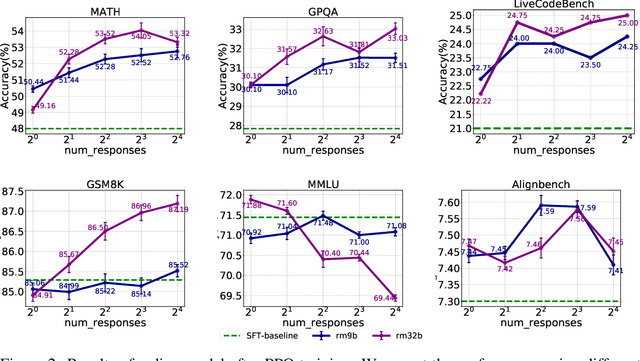
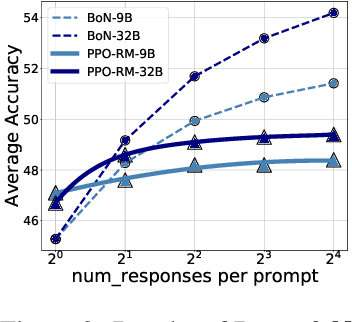
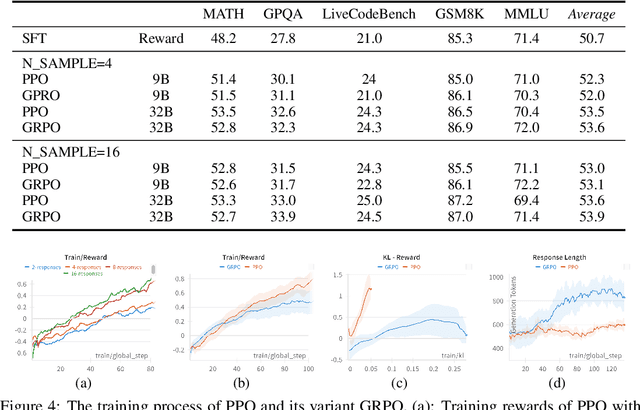
Abstract:This study explores the scaling properties of Reinforcement Learning from Human Feedback (RLHF) in Large Language Models (LLMs). Although RLHF is considered an important step in post-training of LLMs, its scaling potential is still largely unknown. We systematically analyze key components in the RLHF framework--model size, data composition, and inference budget--and their impacts on performance. Our findings show that increasing data diversity and volume improves reward model performance, helping process-supervision models scale better. For policy training, more response samples per prompt boost performance initially but quickly plateau. And larger reward models offer modest gains in policy training. In addition, larger policy models benefit less from RLHF with a fixed reward model. Overall, RLHF scales less efficiently than pretraining, with diminishing returns from additional computational resources. Based on these observations, we propose strategies to optimize RLHF performance within computational limits.
SceneGenAgent: Precise Industrial Scene Generation with Coding Agent
Oct 29, 2024Abstract:The modeling of industrial scenes is essential for simulations in industrial manufacturing. While large language models (LLMs) have shown significant progress in generating general 3D scenes from textual descriptions, generating industrial scenes with LLMs poses a unique challenge due to their demand for precise measurements and positioning, requiring complex planning over spatial arrangement. To address this challenge, we introduce SceneGenAgent, an LLM-based agent for generating industrial scenes through C# code. SceneGenAgent ensures precise layout planning through a structured and calculable format, layout verification, and iterative refinement to meet the quantitative requirements of industrial scenarios. Experiment results demonstrate that LLMs powered by SceneGenAgent exceed their original performance, reaching up to 81.0% success rate in real-world industrial scene generation tasks and effectively meeting most scene generation requirements. To further enhance accessibility, we construct SceneInstruct, a dataset designed for fine-tuning open-source LLMs to integrate into SceneGenAgent. Experiments show that fine-tuning open-source LLMs on SceneInstruct yields significant performance improvements, with Llama3.1-70B approaching the capabilities of GPT-4o. Our code and data are available at https://github.com/THUDM/SceneGenAgent .
LongReward: Improving Long-context Large Language Models with AI Feedback
Oct 28, 2024Abstract:Though significant advancements have been achieved in developing long-context large language models (LLMs), the compromised quality of LLM-synthesized data for supervised fine-tuning (SFT) often affects the long-context performance of SFT models and leads to inherent limitations. In principle, reinforcement learning (RL) with appropriate reward signals can further enhance models' capacities. However, how to obtain reliable rewards in long-context scenarios remains unexplored. To this end, we propose LongReward, a novel method that utilizes an off-the-shelf LLM to provide rewards for long-context model responses from four human-valued dimensions: helpfulness, logicality, faithfulness, and completeness, each with a carefully designed assessment pipeline. By combining LongReward and offline RL algorithm DPO, we are able to effectively improve long-context SFT models. Our experiments indicate that LongReward not only significantly improves models' long-context performance but also enhances their ability to follow short instructions. We also find that long-context DPO with LongReward and conventional short-context DPO can be used together without hurting either one's performance.
Generalizing Graph Transformers Across Diverse Graphs and Tasks via Pre-Training on Industrial-Scale Data
Jul 04, 2024Abstract:Graph pre-training has been concentrated on graph-level on small graphs (e.g., molecular graphs) or learning node representations on a fixed graph. Extending graph pre-trained models to web-scale graphs with billions of nodes in industrial scenarios, while avoiding negative transfer across graphs or tasks, remains a challenge. We aim to develop a general graph pre-trained model with inductive ability that can make predictions for unseen new nodes and even new graphs. In this work, we introduce a scalable transformer-based graph pre-training framework called PGT (Pre-trained Graph Transformer). Specifically, we design a flexible and scalable graph transformer as the backbone network. Meanwhile, based on the masked autoencoder architecture, we design two pre-training tasks: one for reconstructing node features and the other one for reconstructing local structures. Unlike the original autoencoder architecture where the pre-trained decoder is discarded, we propose a novel strategy that utilizes the decoder for feature augmentation. We have deployed our framework on Tencent's online game data. Extensive experiments have demonstrated that our framework can perform pre-training on real-world web-scale graphs with over 540 million nodes and 12 billion edges and generalizes effectively to unseen new graphs with different downstream tasks. We further conduct experiments on the publicly available ogbn-papers100M dataset, which consists of 111 million nodes and 1.6 billion edges. Our framework achieves state-of-the-art performance on both industrial datasets and public datasets, while also enjoying scalability and efficiency.
ChatGLM: A Family of Large Language Models from GLM-130B to GLM-4 All Tools
Jun 18, 2024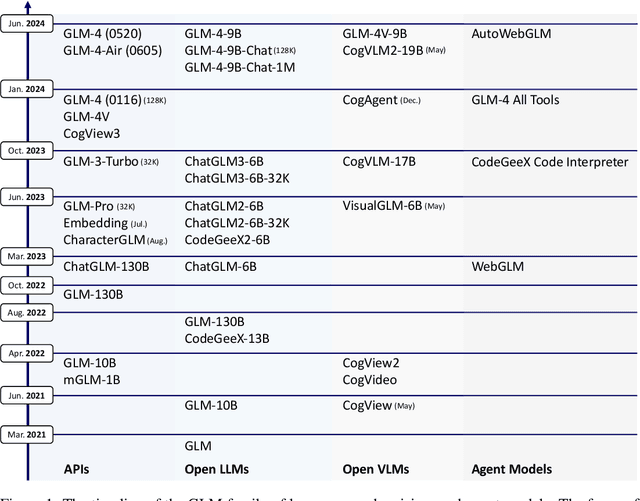
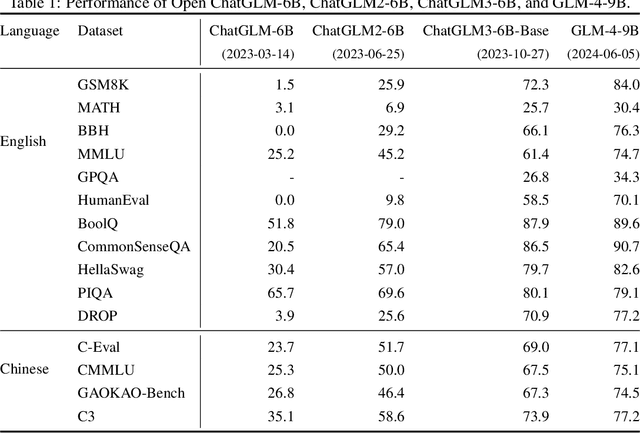
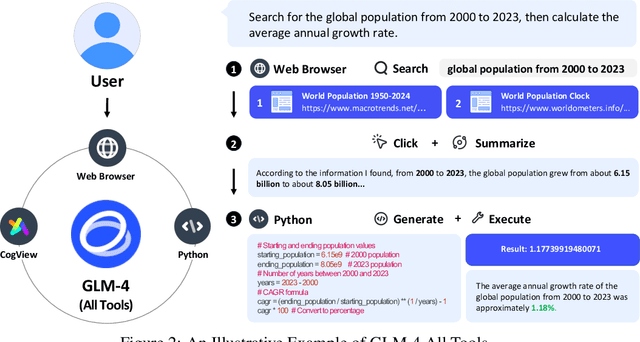
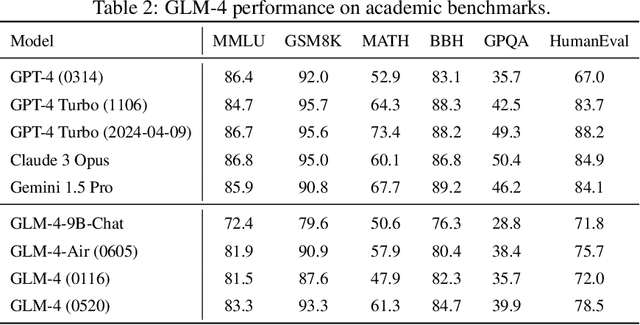
Abstract:We introduce ChatGLM, an evolving family of large language models that we have been developing over time. This report primarily focuses on the GLM-4 language series, which includes GLM-4, GLM-4-Air, and GLM-4-9B. They represent our most capable models that are trained with all the insights and lessons gained from the preceding three generations of ChatGLM. To date, the GLM-4 models are pre-trained on ten trillions of tokens mostly in Chinese and English, along with a small set of corpus from 24 languages, and aligned primarily for Chinese and English usage. The high-quality alignment is achieved via a multi-stage post-training process, which involves supervised fine-tuning and learning from human feedback. Evaluations show that GLM-4 1) closely rivals or outperforms GPT-4 in terms of general metrics such as MMLU, GSM8K, MATH, BBH, GPQA, and HumanEval, 2) gets close to GPT-4-Turbo in instruction following as measured by IFEval, 3) matches GPT-4 Turbo (128K) and Claude 3 for long context tasks, and 4) outperforms GPT-4 in Chinese alignments as measured by AlignBench. The GLM-4 All Tools model is further aligned to understand user intent and autonomously decide when and which tool(s) touse -- including web browser, Python interpreter, text-to-image model, and user-defined functions -- to effectively complete complex tasks. In practical applications, it matches and even surpasses GPT-4 All Tools in tasks like accessing online information via web browsing and solving math problems using Python interpreter. Over the course, we have open-sourced a series of models, including ChatGLM-6B (three generations), GLM-4-9B (128K, 1M), GLM-4V-9B, WebGLM, and CodeGeeX, attracting over 10 million downloads on Hugging face in the year 2023 alone. The open models can be accessed through https://github.com/THUDM and https://huggingface.co/THUDM.
GraphAlign: Pretraining One Graph Neural Network on Multiple Graphs via Feature Alignment
Jun 05, 2024Abstract:Graph self-supervised learning (SSL) holds considerable promise for mining and learning with graph-structured data. Yet, a significant challenge in graph SSL lies in the feature discrepancy among graphs across different domains. In this work, we aim to pretrain one graph neural network (GNN) on a varied collection of graphs endowed with rich node features and subsequently apply the pretrained GNN to unseen graphs. We present a general GraphAlign method that can be seamlessly integrated into the existing graph SSL framework. To align feature distributions across disparate graphs, GraphAlign designs alignment strategies of feature encoding, normalization, alongside a mixture-of-feature-expert module. Extensive experiments show that GraphAlign empowers existing graph SSL frameworks to pretrain a unified and powerful GNN across multiple graphs, showcasing performance superiority on both in-domain and out-of-domain graphs.
ChatGLM-Math: Improving Math Problem-Solving in Large Language Models with a Self-Critique Pipeline
Apr 03, 2024Abstract:Large language models (LLMs) have shown excellent mastering of human language, but still struggle in real-world applications that require mathematical problem-solving. While many strategies and datasets to enhance LLMs' mathematics are developed, it remains a challenge to simultaneously maintain and improve both language and mathematical capabilities in deployed LLM systems.In this work, we tailor the Self-Critique pipeline, which addresses the challenge in the feedback learning stage of LLM alignment. We first train a general Math-Critique model from the LLM itself to provide feedback signals. Then, we sequentially employ rejective fine-tuning and direct preference optimization over the LLM's own generations for data collection. Based on ChatGLM3-32B, we conduct a series of experiments on both academic and our newly created challenging dataset, MathUserEval. Results show that our pipeline significantly enhances the LLM's mathematical problem-solving while still improving its language ability, outperforming LLMs that could be two times larger. Related techniques have been deployed to ChatGLM\footnote{\url{https://chatglm.cn}}, an online serving LLM. Related evaluation dataset and scripts are released at \url{https://github.com/THUDM/ChatGLM-Math}.
 Add to Chrome
Add to Chrome Add to Firefox
Add to Firefox Add to Edge
Add to Edge